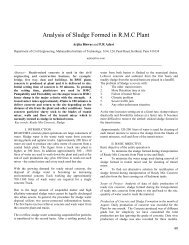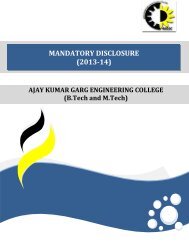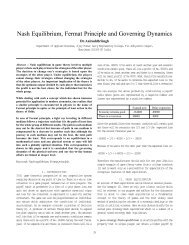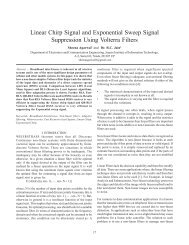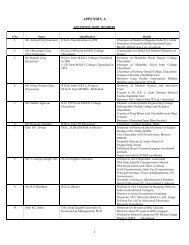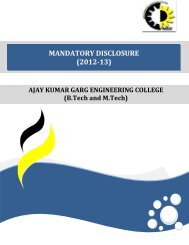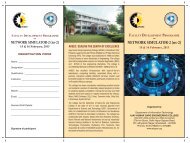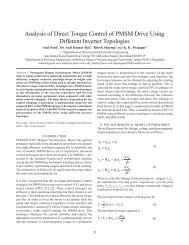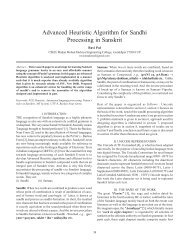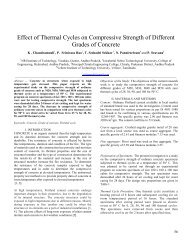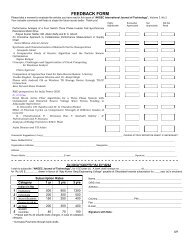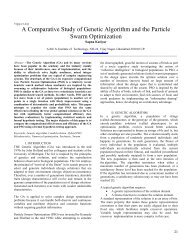Architectural designs and Constructability Issues
Architectural designs and Constructability Issues
Architectural designs and Constructability Issues
Create successful ePaper yourself
Turn your PDF publications into a flip-book with our unique Google optimized e-Paper software.
ARCHITECTURAL DESIGN ISSUES<br />
in the planning <strong>and</strong> design processes is a major factor that<br />
leads to constructability problems during the construction<br />
stage. This is because many design professionals have little<br />
experience in construction practices, local considerations, the<br />
availability of different resources, <strong>and</strong> are not necessarily<br />
experts in construction means <strong>and</strong> methods. During the<br />
procurement phase, contractor reliance on contract documents<br />
to visualize the construction process <strong>and</strong> decide on appropriate<br />
construction methods is limited to 2D drawings. This approach<br />
limits the contractor’s ability to be more familiar with the project<br />
at this early stage <strong>and</strong> prior to the start of actual construction.<br />
During the construction stage, constructability issues such<br />
as safety, storage access, security, quality, <strong>and</strong> schedule<br />
updating are major factors that influence the accomplishment<br />
of a successful project.<br />
II. NEED FOR STUDY<br />
Purpose<br />
As projects get more <strong>and</strong> more complex the issue of<br />
constructability becomes important. <strong>Constructability</strong> infiltrates<br />
all parts of a project, especially those related to the engineering<br />
<strong>and</strong> architectural professions. With projects becoming more<br />
<strong>and</strong> more complex <strong>and</strong> time frames shorter <strong>and</strong> shorter, implied<br />
warranty <strong>and</strong> severe professional liability issues may arise.<br />
Design professionals need to be aware of the potential issues<br />
<strong>and</strong> claims implied by a design’s constructability or build ability<br />
profile. When a project has inherent constructability issues,<br />
resulting litigation can involve delay claims, change order<br />
issues <strong>and</strong> disputes, <strong>and</strong> owner’s dissatisfaction with delivery.<br />
In extreme situations, direct claims may be made against the<br />
design principal for poor plans, specifications or estimates, or<br />
schedules that have made the project difficult to build, or more<br />
costly or time consuming than anticipated.<br />
The issue is well recognized in the construction industry, but<br />
what is not so well recognized is when to do constructability<br />
reviews, who should do them <strong>and</strong> how they should be done.<br />
This Practice Note provides suggestions <strong>and</strong> a methodology<br />
for conducting constructability reviews of projects of all types<br />
<strong>and</strong> sizes. <strong>Constructability</strong> issues not only involve issues of<br />
build ability, but also the sequence of construction <strong>and</strong><br />
integration of systems in a logical sequence using st<strong>and</strong>ard<br />
substructures.<br />
There are two purposes for the formation of the collecting of<br />
<strong>Constructability</strong> issues. These include:<br />
• To create an ongoing forum for the definition of a<br />
constructability body of knowledge through the<br />
compilation of case studies related to architectural<br />
<strong>designs</strong><br />
• To provide a case study data set for academic education<br />
in architectural engineering<br />
Features<br />
<strong>Constructability</strong> is a project management technique for<br />
reviewing construction processes from start to finish during<br />
the pre-construction phrase[13]. It will identify obstacles before<br />
a project is actually built to reduce or prevent error, delays <strong>and</strong><br />
cost overruns. The term “constructability” is referred to as:<br />
• The extent to which the design of the building facilitates<br />
ease of construction, subject to the overall requirements<br />
for the completed building[13]<br />
• A system for achieving optimum integration of<br />
construction knowledge <strong>and</strong> experience in planning,<br />
engineering, procurement <strong>and</strong> field operations in the<br />
building process, <strong>and</strong> balancing the various project <strong>and</strong><br />
environmental constraints to achieve overall<br />
objectives[13]<br />
• A system for achieving optimum integration of<br />
construction knowledge in the building process <strong>and</strong><br />
balancing the various project <strong>and</strong> environmental<br />
constraints to maximize achievement of project goals <strong>and</strong><br />
building performance[13]<br />
III. LITERATURE REVIEW<br />
Following points emerged from the literatures review:<br />
1. <strong>Constructability</strong> improvement strategies: Several strategies<br />
<strong>and</strong> concepts have been presented to improve the project<br />
constructability during the different phases of the preconstruction<br />
stage. Tatum recommended the use of the<br />
“backward pass” approach to planning to ensure that the<br />
schedule is driven by the construction needs. Galvanic<br />
described two methods for improving constructability <strong>and</strong><br />
decreasing design-related problems during the construction<br />
process: (1) Design Phase Scheduling, <strong>and</strong> (2) In-House<br />
Design-Phase <strong>Constructability</strong> Review. O’Connor et al<br />
identified seven concepts for improving constructability<br />
during the design/procurement phases of a project: (1) a<br />
Construction-Driven schedule, (2) Simplified Design, (3)<br />
st<strong>and</strong>ardization of design, (4) Pre-assembly work should be<br />
scoped in advance <strong>and</strong> pre-assembly <strong>designs</strong> should be<br />
prepared to facilitate fabrication, transport, <strong>and</strong> installation,<br />
<strong>and</strong> thus to enhance project constructability. (5) Accessibility,<br />
(6) Adverse Weather, (7) Specifications.[1]<br />
2. <strong>Constructability</strong> improvement solution models: Different<br />
solution models for constructability improvement were<br />
implemented to assist the project team in integrating<br />
construction knowledge/experience during the preconstruction<br />
stage. Fischer presented a Construction<br />
Knowledge Expert (COKE) that guides designers towards<br />
designing structures that are more constructible. Patty et al.<br />
presented a computer tool that utilizes a multimedia to give the<br />
designer the capability of accessing constructability<br />
information at the point of design. Moore <strong>and</strong> Tunnicliffe<br />
described aspects of the production of an Automated Design<br />
Aid (ADA) that provides the designer with useful decision<br />
9



